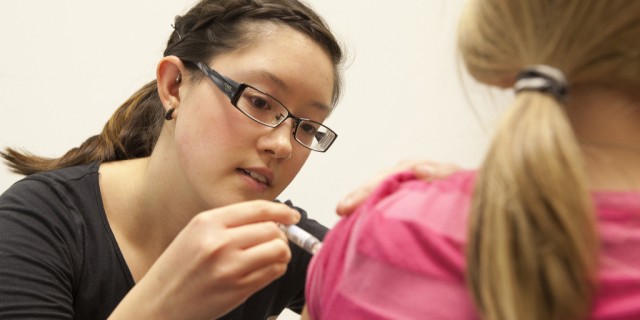Not sexy, maybe, but important.
Statewide, 2.54 percent of children have a personal belief exemption on file, but 6.86 percent of kindergarteners enter school under-vaccinated.
“Under-vaccinated is still making you vulnerable for disease, for getting the disease, and for transmitting the disease,” Pine said.
These students may lawfully enter kindergarten on a “conditional basis,” with some, but not all, of their required shots. The condition is that they’ll get up to date soon.
The problem is, it’s nearly impossible to tell if this ever happens. State and county health officials say it’s up to the schools to keep track. But, there is no official reporting required by schools after they submit their vaccination rates to the state in the fall. The schools are the ones charged with sending notices to parents and excluding kids from school who don’t get up to date within 10 days of those notifications.
But, there's a powerful disincentive to keep kids out of school. Several school nurses reminded me that schools get paid by how many kids are in school each day.
“In general, we have not made a practice of turning students away,” said Troy Flint, spokesperson for Oakland Unified. The Los Angeles Unified School District also said they didn’t keep any “conditional entrants” out of school last year for failing to get the rest of their shots.
Los Angeles Unified also did not know how many of their “conditional entrants” ended up fully vaccinated by the end of the 2013-2014 school year. Los Angeles county's conditional entry rate is 12.28 percent, nearly twice the state average. San Francisco's rate is 11.62 percent.
But neither of those counties is taking big steps to curb this problem. It’s Alameda County officials who say their rate of 9.68 percent must be fixed.
“We have a conditional-entrant problem here,” insisted Pine.. “They’re not immunized. They’re not protected.”
Together with Dr. Kristen Lum, a pediatric resident at UC San Francisco Benioff Children’s Hospital Oakland, Pine visited Alameda County schools this fall with chronically high rates of conditional entrants.
Pine and Lum have made recommendations to the schools, to Oakland Unified School District, to the county, and to the state. They hope their recommendations will improve tracking of “conditional entrants,” and ultimately, immunization rates statewide.
Alameda County’s commitment comes at a critical time in California, with 91 confirmed cases of measles, and the 2014 statewide whooping cough epidemic left two infants dead and sickened nearly 11,000 people.
A child could be under-vaccinated for a number of reasons, including lack of training or personnel resources for school staff charged with tracking students; families moving in and out of care; or parents who are unable to get a child to the doctor in time.
Pine hopes that her team can change some of this.
“There’s nothing like an outbreak to remind people about the importance of getting vaccinated,” she said. “Unfortunately it has to come to an outbreak or a vaccine shortage to get people lined up.”
Lauren M. Whaley is the multimedia journalist for the CHCF Center for Health Reporting.
